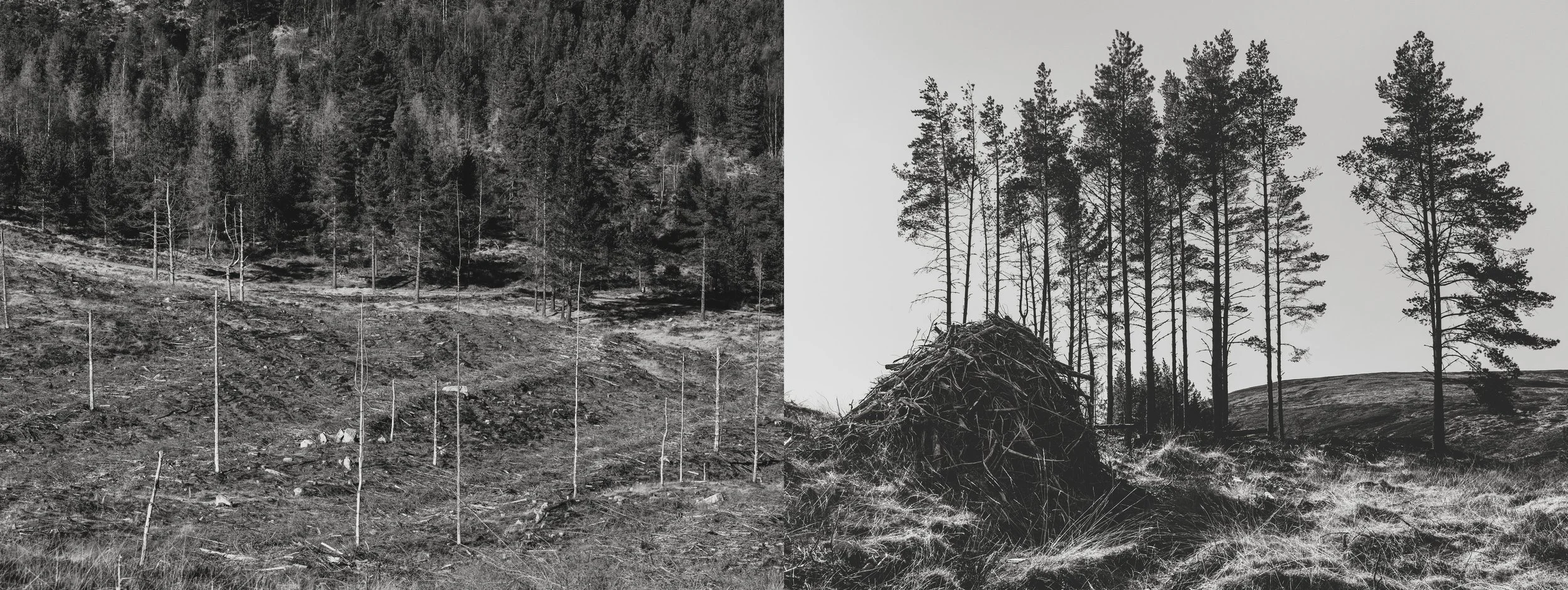Where once we stood on Scragged Oak Hill - rekindling an animistic worldview.
Where Once We Stood on Scragged Oak Hill is an ongoing project situated in areas of woodland that have been recently felled, thinned, or otherwise altered. In these disturbed environments, I collect branches, twigs, and debris left behind by logging or clearance work. Using these materials, I construct temporary sculptural forms—assemblages that are suggestive of the human figure or archaic symbolic systems. I refer to these as Forest Figures.
The project began during a visit to Glen Lyon in Scotland, where I encountered a vast area of felled woodland. While it was clear that the intention was ecological—likely the removal of Sitka spruce monoculture in preparation for replanting with native Caledonian pine—the exposed terrain was nevertheless visually and emotionally arresting. The land was raw and open, scattered with towering piles of broken branches gathered by forestry machinery. These accumulations of limbs, heaped and splintered, had a strange anthropomorphic quality—as if the forest were attempting to reassemble itself. That image became one of the early catalysts for the work.
The project’s title originates from a place I knew well—Scragged Oak Hill, a name found on local Ordnance Survey maps. In that area once stood a grove of hemlocks I had often visited. On returning one day, I found them gone. The trees had been felled, and nothing remained but scattered branches and disordered limbs. In response, I assembled a figure from the remains—a simple form constructed from the site’s debris. I called it Remains of Hemlock (below). That was the first Forest Figure, and the beginning of the project.
These structures are deliberately fragile. They are not intended to function as permanent sculptures or land art installations. Their role is to exist temporarily—as subjects of photographic documentation—and then to decay naturally. Their impermanence is integral to the work.
The project engages with the landscape as both material and context. It responds directly to the absence created by deforestation, and to the residual matter that remains on the forest floor. By assembling forms from this material, the work attempts a gesture of recognition: an acknowledgement of disruption (even if it is ecologically necessary) and an act of remembrance for the lost or altered forest.
The Forest Figures function as symbolic markers. Their humanoid or cuneiform-like shapes evoke the possibility of language, ritual, or presence, without offering a fixed or readable message. They are not intended to represent specific individuals or mythologies, but rather to suggest a residual or ancestral presence—something that remains after erasure. The Forest Figures draw, albeit indirectly, on older symbolic traditions—specifically animistic belief systems and European folk representations of nature. Figures such as the Green Man or the Woodwose embodied a personified, often unruly natural world—beings that blurred the boundary between human and landscape. While not literal depictions of these mythic forms, the Forest Figures can be understood as a contemporary reimagining of that impulse: to give shape to nature as an active, sentient force. Their upright, humanoid structures echo these older archetypes, not as nostalgic revival, but as an attempt to acknowledge the continued relevance of such symbolic frameworks in an era of ecological disruption. In this context, the figures act less as characters and more as provisional stand-ins for what has been displaced—temporary embodiments of a forest no longer fully present.
As a practice, this work is informed by ideas of impermanence, trace, and symbolic connection. It asks how small, provisional gestures might register significance in landscapes that have been subject to abrupt and often invisible forms of transformation. It also questions what it means to ‘respond’ to environmental change without claiming to restore, repair, or resolve it.
Photography plays a key role in the project. The images produced are not documentation in the traditional sense, but a means of framing these ephemeral interventions and giving them a degree of visibility and intentionality. Once photographed, the figures are left to disintegrate and most of the figures have now fallen or decayed, though a few may still remain; I’m interested in how they might be encountered without context—whether as remnants of a ritual, markers, or simply anomalies in the landscape.
Ultimately, Where Once We Stood on Scragged Oak Hill occupies the intersection between sculpture, performance, and site-based practice. It is concerned with how art can operate as a minimal, non-intrusive gesture—an acknowledgment of loss that avoids spectacle or permanence.
Alastair Mackie put it perfectly in his introduction the the AFTERIMAGE show:
“There is something quietly romantic in these gestures - small acts that recognise their own impermanence, yet insist on the value of bearing witness. Set against the scale of geological time, these tender endeavours find meaning in the attempt itself: a desire to make sense of our place in time and space.
Rather than lamenting what has been lost or attempting to preserve an idealised past, these works suggest new possibilities. They propose that meaning might be found in the everyday and the overlooked. A simple gesture - the arrangement of found objects, the carving of a single word, the burial of something impossibly small - becomes a way of bearing witness to the world's continual becoming.”






